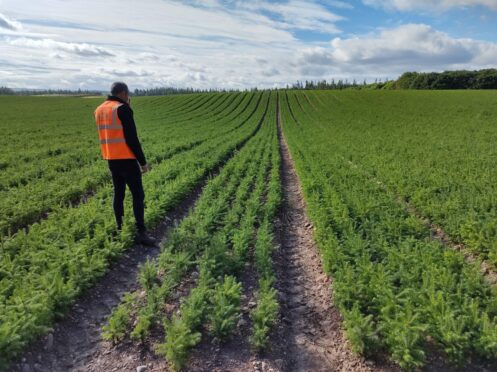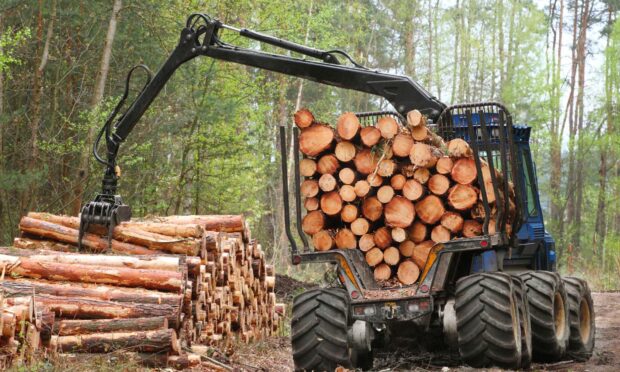Every year, Maelor Forest Nurseries grows between 10 and 15 million trees at our site in Moray – in the Darnaway Forest, near Conicavel, by Forres.
We grow species such as Sitka spruce and Norway spruce for timber-producing forests, as well as Scots pine, and a wide range of broadleaf species, including silver birch, alder and rowan.
Tree nurseries are typically seasonal, but the scale of our operation means we work almost all year round.
We lift the trees typically from November onwards, depending on the species, because they are dormant in the winter season, which makes it the perfect time for planting them.
That means the winter is a very busy time for Maelor as we lift, grade and pack the trees – and send them off to customers to plant in forests and woodlands across the country.
The bare root tree planting season typically runs from December through to April, and we move millions of trees during that time.
Customers include large and small estates, and we are always keen to work with more estates in the region.
We also deliver to private sector management companies planting large forests, and to the public agency, Forestry and Land Scotland, as well as fulfilling smaller-scale orders for charities and farmers.
Currently, Scotland is doing really well in terms of tree planting, with 80% of all the UK’s new woodland created here.
However, young trees in the nursery typically take two years to grow, and some species can take as long as four years. So, we have to plan ahead as best we can.
Clients often want specific genetics or provenance, to give the tree a greater chance of surviving and thriving through the life of the forest – and producing good-quality timber.
Generally, we do this by working to contract, supplying clients with the species and size required, so they get what they want – and we can sell the trees we grow.
All our clients want healthy, vigorous trees, which are the right specification for their needs.
On a good new planting site, they might want trees of say 20-40 centimetres, but if the trees are going into a bumpy and undulating restock site, they might want something a bit bigger.
To ensure the clients get what they need, our operations have to be very well planned.
We have to plant and lift trees at just the right time.
We must get it right in terms of husbandry – applying fertiliser, keeping pests under control, and managing weed growth.
Hopefully, we achieve that – and our site (which is around 175 acres) looks very tidy.
We grow our trees out in the open so we are subject to the vagaries of the weather.
Luckily, Moray has an unusual micro-climate – it’s quite sheltered, with predictable rainfall and slightly higher temperatures and the land is very fertile.
It’s a great place for a tree nursery.
We’re really busy prepping, planting and tending the crops from April through the summer and then we have a slightly quieter period for maybe four or five weeks in August and September before we pick up again and start the preparations to lift the crops.
Maleor also has a large nursery in north Wales, and the two sites between them are growing around 35-40 million trees annually.
We opened the Moray site four years ago for logistical and operational reasons – lots of people wanted trees in Scotland.
We employ around 30 people on the site and we have invested in a new cold store and grading facilities – and are always reviewing opportunities to expand.
The forestry sector in Scotland is in a positive place, and we hope the industry will continue to thrive.
The whole of the UK needs to grow and use more sustainable timber to support its efforts to tackle climate change, so there is a strong environmental case for producing more home-grown timber.
It is also important for our regional economy, from nurseries like ours through to forest management companies and contractors and into large sawmillers like BSW in Fort William, James Jones & Sons in Aboyne, Mosstodloch and Forres, John Gordon & Sons in Nairn, Munros in Dingwall and Cordiners in Banchory.
The industry has a strong supply chain, but there is always uncertainty around policy and customer demand so we have to stay close to the market, talking to customers and understanding what’s coming down the line and moving things around if necessary.
We need certainty from policy-makers and if the brakes are slammed on planting in any given year, that’s devastating for the whole supply chain.
Businesses like Maelor can only flourish with a clear commitment to planting by politicians.
At the moment, we’re in a positive place – Maelor is very happy to be part of the forestry and wood supply chain and all that it does for our economy and environment.
Ben Goh is commercial manager for Maelor Forest Nurseries.



Conversation